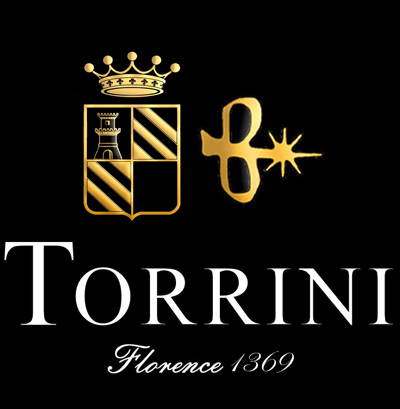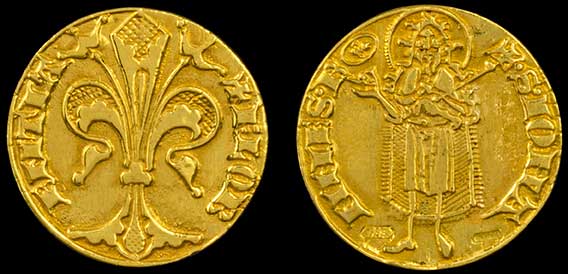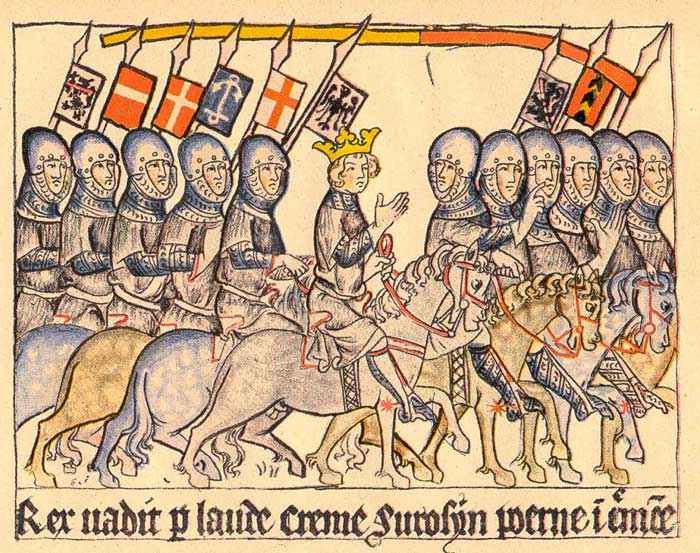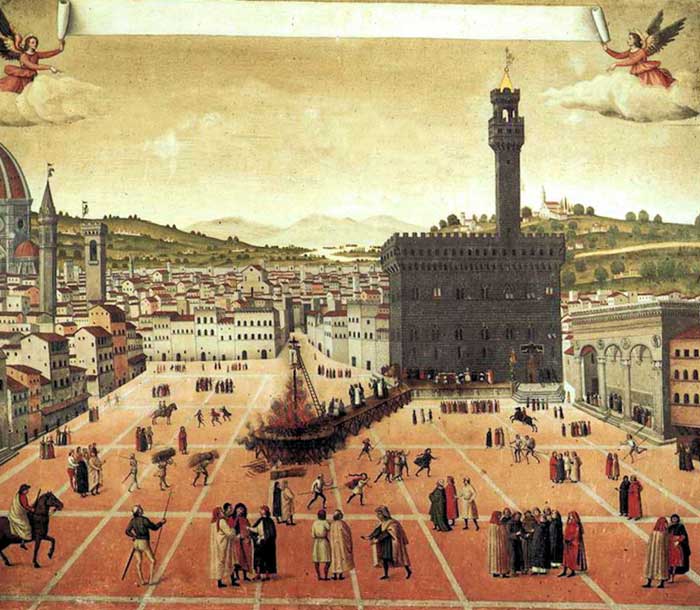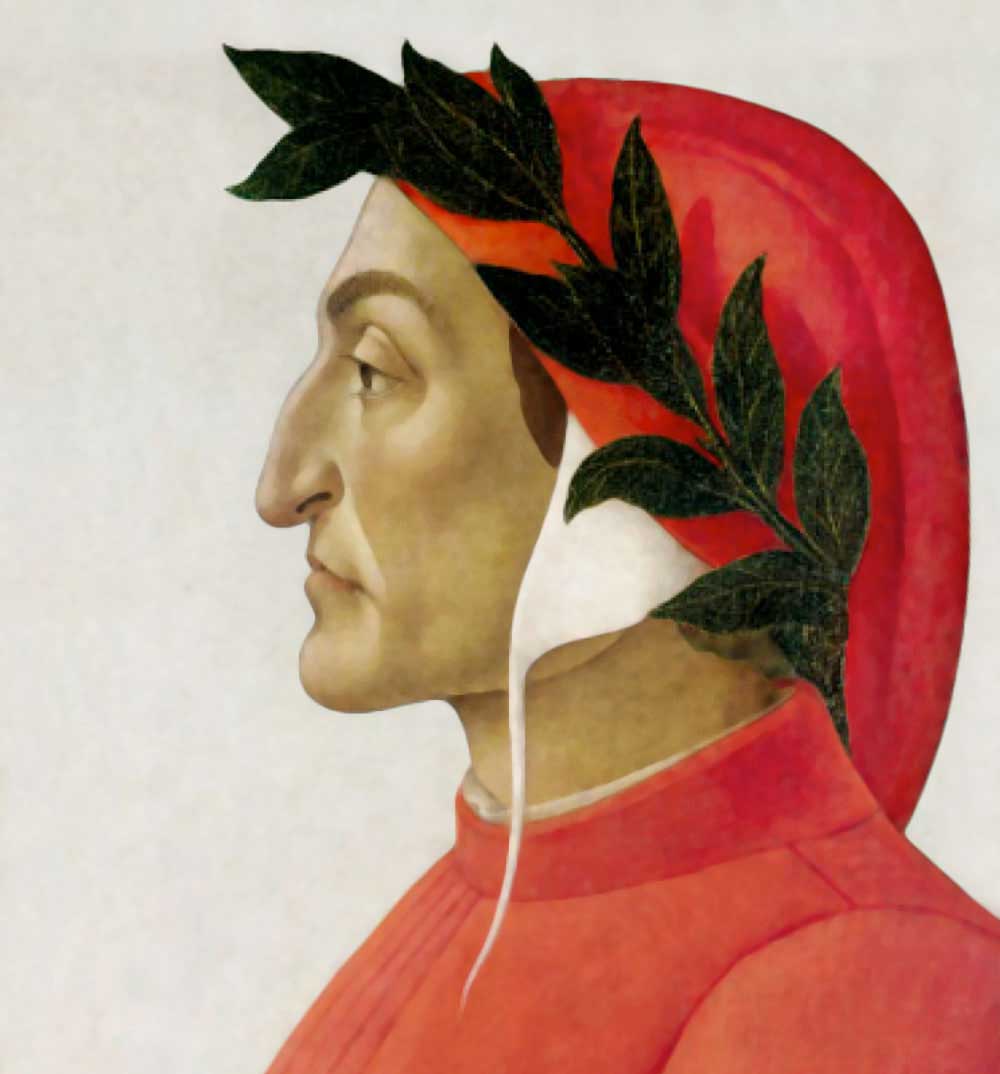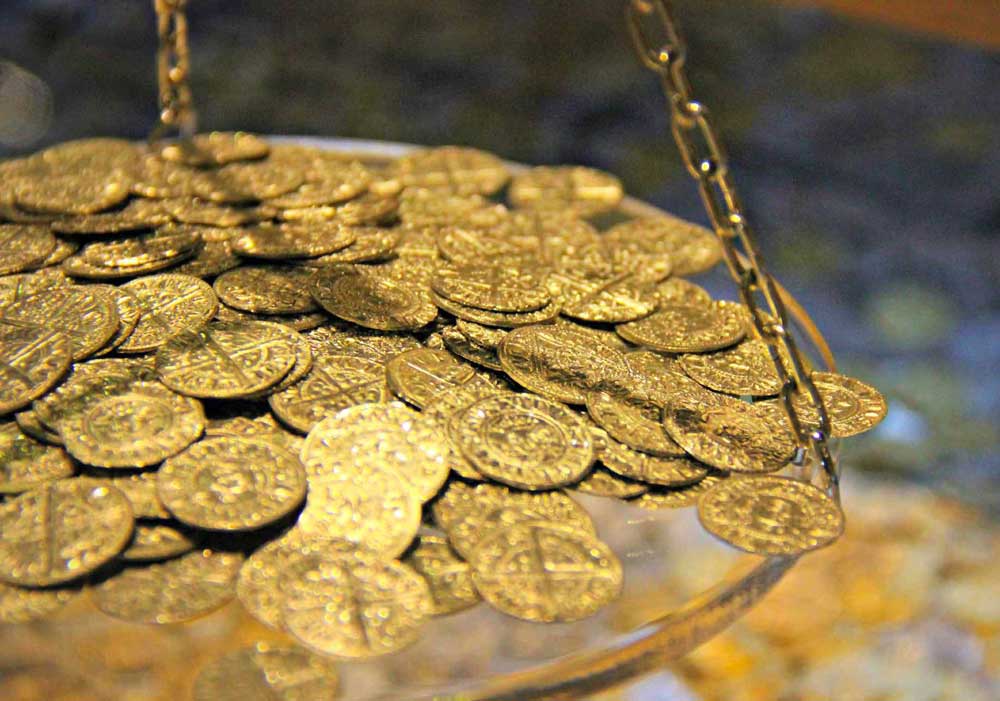- Creation of the cone: The chosen blacksmith worked the metal creating a rough cylindrical cone.
- The Incision: The task of the engraver to create works of art on the rough cone with small tools. The two incisions had to be approved by the Master of Mint.
- Temperature: After the approval of the incisions, the blacksmith tempered the cone to make it more resistant given the high number of coins to be minted.
Gold Florin and Florentine Coins

Gold Florin
The Gold Florin is a coin made from pure 24 carat gold approximately 3,536 grams, minted in Florence in 1252.
The coin on one side has represented the elegant lily of Florence, the emblem of the city with the words “FLOR–ENTIA. On the other side of the coin, there is represented the figure of St. John the Baptist, the patron of the city of Florence joined with inscription "S. IOHA-NNES B.".
The particular beauty of the Gold Florin is its unmistakable prestige in the international markets, having become the most valuable coin currency of all Europe. Justifying the incredible number of copies, even more that 350, which has been made throughout time!
Florentine Coin World

Index
Index






Gold Florin Coin in History

Gold Florin Coin. How was it born?
Florence 1252. Filippo Ugoni, the mayor, gave permission to the Captain of the People to mint his own coin because of the economic growth of the city.
The Florentines decided to create a coin in pure gold with the sole purpose to maintain a fixed value, since it had a stable weight and minting was of high quality.
Consequently, this became very popular in Europe and son the Gold Florin became a currency of exchange in the known world.

Before the Gold Florin
During the early Middle Ages, the Saracen attacks had made trade difficult in the Mediterranean, and the circulation of money became rare.
In the era of Charlemagne, the gold coin and the silver coin disappeared quickly with the entire empire, which then were replaced with more modest coins made from copper.
The great feudal lords took over the power of minting, kept part of the silver and gold and had begun issuing low valued coins.
These forgeries created a disarray, especially in the banking sector, and for this reason the main Italian cities had to create a new and more valuable currency to trade. The use of gold for coins was made possible due to the restarting trade with North Africa, from where most of the gold coins and trade came from.
Florence coined the Gold Florin, made of pure gold to be established on all markets until it became the European common currency, where all the others had to use it. This was one of the first pure gold coins to be minted in Italy after the fall of the Roman Empire.

Gold Florin prey to counterfeiters
The Gold Florin circulated all over Europe and gained the attention of many who ended up falsifying the coin, over 350 copies were made.
There were severe penalties for the falsification of the coins, since the control over the Florentine Florins was constant, they became one of the most stable and appreciated gold coins according to the European bankers in the Middle Ages and the Renaissance.
Due to the mindset of the era, the figure of the was the guarantee of authenticity because it drives from the Florentine saying "San Giovanni non vuole inganni”, which translates to: St. John does not want deceptions.
The circulation of the gold was limited to the higher classes because of its great value. The gold florins were only used for certain financial transactions, meanwhile for ordinary transactions the people would use divisional coins called “pìccioli”, which were money and silver coins.
In order to avoid the fraudulent practice of scraping the gold coins to obtain gold, called “tosatura”, the coins were sealed in a bag by the Mint for them to be used without having to take them out of the bag.
Florentine Minting

The production process of the Gold Florin
The lord of the mint was a master officially pointed byFlorence every six months by the members of the “Arte di Calimala”, with thetask of guaranteeing the quality of the coins and the supervision over the workof the Florentine Mint.
The representation of the Florentine coin was rigorously kept the same, not identical because the cones were replaced biannually, yet bearing the elegant Florentine lily on the reverse and on the other side shows the figure of St. John the Baptist, patron of Florence. The symbol of the Master of Mint is stamped above the hand of the figure of St. John.
The creation of the biannual cones were performed in three steps:
Creation of the cone: The chosen blacksmith worked the metal creating a rough cylindrical cone.
The Incision: The task of the engraver to create works of art on the rough cone with small tools. The two incisions had to be approved by the Master of Mint.
Temperature: After the approval of the incisions, the blacksmith tempered the cone to make it more resistant given the high number of coins to be minted.

The minting of the Gold Florin
Everything was made by hand with the help of hammers, ironpieces, anvils, burins, and small chisels. The lower cone, where the front partof the coin is engraved is called “Pila”, was attached directly to the woodenblock. The upper cone, called “Torselo”, was where the coin maker would struckthe gold with a water pressure hammer activated by the Arno river.
The “Remissori” were the officials of the “Arte di Calimala” that were in charge of checking the gold, the casting, the recovery of the imperfect coins, the trimmings and the gold dust residue of the fillings.

The Gold Florin and Florentine minting
Florence gave the responsibility to control every phase ofthe minting of the Gold Florin to the “Arte di Calimala”, the most ancient of associations from which Florentine merchants belonged to.
In 1345, the main headquarters of the minting took place in the actual Piazzale of the Uffizi, where they would use water operated hammers of the Scheraggio stream for the minting. Afterwards the operations were moved to where is currently the Mint Tower in Piazza Piave, adjacent to the Arno river to ease the minting labor.
Many times, the artisans could not perfectly stamp the coins because of the weight of the hammers, producing coins with not a good impression. These imperfect gold Florins had an excess of gold called “calia”, which could have been filed away, but would have lowered the value of the coin.
To avoid the devaluation of the gold coins, the officials ofthe “Arte di Calimala” would weigh every single gold coin by placing them insealed bags and would observe that the figure of St. John appeared perfectly upside down compared to the Florentine Lily, to ensure the weight of the gold coins were constant. These were the "Fiorini di Suggello", ensuring the quality and the weight of the gold.
Gold Florentine Coins, complete Overview

Gold Florin 1256
In 1369, our ancestor Jacopus de la Scarperia registered the trademark of the Torrini Workshop at the “Arte dei Corazzai e Spadai” in Florence. In the same year, the Mint Master Simone Peruzzi engraved a new mint for the gold Florin.
The coin that was created on the basis of the wealth and economic success of Florence, following the city’s development until the fall of the Republic in 1533.

Gold Florin 1369
A popular saying “St. John does not want deceptions.”, is areligious proverb, widespread and used daily in Italy, where it’s meaning varies from region to region. It is thought that in Florence the saying derives from the Florin. As previously mentioned, one of the sides of the Florin bears the elegant Florentine Lily, while the other side presents the patron of Florence, St. John the Baptist.
Having the patron on the reverse side of the coin was considered a guarantee of the purity of the gold coin. Considering if one were to forge the Florin it would be a serious crime against the Municipality of Florence and also against God for trying to steal directly from a Saint.

Gold Florin 1427
In 1369, our ancestor Jacopus de la Scarperia registered the trademark of the Torrini Workshop at the “Arte dei Corazzai e Spadai” in Florence. In the same year, the Mint Master Simone Peruzzi engraved a new mint for the gold Florin.
The coin that was created on the basis of the wealth and economic success of Florence, following the city’s development until the fall of the Republic in 1533.

Quarter of Florin
A popular saying “St. John does not want deceptions.”, is areligious proverb, widespread and used daily in Italy, where it’s meaning varies from region to region. It is thought that in Florence the saying derives from the Florin. As previously mentioned, one of the sides of the Florin bears the elegant Florentine Lily, while the other side presents the patron of Florence, St. John the Baptist.
Having the patron on the reverse side of the coin was considered a guarantee of the purity of the gold coin. Considering if one were to forge the Florin it would be a serious crime against the Municipality of Florence and also against God for trying to steal directly from a Saint.

Double Florin
In 1369, our ancestor Jacopus de la Scarperia registered the trademark of the Torrini Workshop at the “Arte dei Corazzai e Spadai” in Florence. In the same year, the Mint Master Simone Peruzzi engraved a new mint for the gold Florin.
The coin that was created on the basis of the wealth and economic success of Florence, following the city’s development until the fall of the Republic in 1533.

Mezzo Zecchino
A popular saying “St. John does not want deceptions.”, is areligious proverb, widespread and used daily in Italy, where it’s meaning varies from region to region. It is thought that in Florence the saying derives from the Florin. As previously mentioned, one of the sides of the Florin bears the elegant Florentine Lily, while the other side presents the patron of Florence, St. John the Baptist.
Having the patron on the reverse side of the coin was considered a guarantee of the purity of the gold coin. Considering if one were to forge the Florin it would be a serious crime against the Municipality of Florence and also against God for trying to steal directly from a Saint.

Gold Ruspone
In 1369, our ancestor Jacopus de la Scarperia registered the trademark of the Torrini Workshop at the “Arte dei Corazzai e Spadai” in Florence. In the same year, the Mint Master Simone Peruzzi engraved a new mint for the gold Florin.
The coin that was created on the basis of the wealth and economic success of Florence, following the city’s development until the fall of the Republic in 1533.

Gold Plate
A popular saying “St. John does not want deceptions.”, is areligious proverb, widespread and used daily in Italy, where it’s meaning varies from region to region. It is thought that in Florence the saying derives from the Florin. As previously mentioned, one of the sides of the Florin bears the elegant Florentine Lily, while the other side presents the patron of Florence, St. John the Baptist.
Having the patron on the reverse side of the coin was considered a guarantee of the purity of the gold coin. Considering if one were to forge the Florin it would be a serious crime against the Municipality of Florence and also against God for trying to steal directly from a Saint.

Ongaro di Livorno
In 1369, our ancestor Jacopus de la Scarperia registered the trademark of the Torrini Workshop at the “Arte dei Corazzai e Spadai” in Florence. In the same year, the Mint Master Simone Peruzzi engraved a new mint for the gold Florin.
The coin that was created on the basis of the wealth and economic success of Florence, following the city’s development until the fall of the Republic in 1533.
Silver Florentine Coins

Grosso da due soldi
In 1369, our ancestor Jacopus de la Scarperia registered the trademark of the Torrini Workshop at the “Arte dei Corazzai e Spadai” in Florence. In the same year, the Mint Master Simone Peruzzi engraved a new mint for the gold Florin.
The coin that was created on the basis of the wealth and economic success of Florence, following the city’s development until the fall of the Republic in 1533.

Grosso Guelfo
A popular saying “St. John does not want deceptions.”, is areligious proverb, widespread and used daily in Italy, where it’s meaning varies from region to region. It is thought that in Florence the saying derives from the Florin. As previously mentioned, one of the sides of the Florin bears the elegant Florentine Lily, while the other side presents the patron of Florence, St. John the Baptist.
Having the patron on the reverse side of the coin was considered a guarantee of the purity of the gold coin. Considering if one were to forge the Florin it would be a serious crime against the Municipality of Florence and also against God for trying to steal directly from a Saint.

Quinto di Scudo
In 1369, our ancestor Jacopus de la Scarperia registered the trademark of the Torrini Workshop at the “Arte dei Corazzai e Spadai” in Florence. In the same year, the Mint Master Simone Peruzzi engraved a new mint for the gold Florin.
The coin that was created on the basis of the wealth and economic success of Florence, following the city’s development until the fall of the Republic in 1533.

Star of Florin
A popular saying “St. John does not want deceptions.”, is areligious proverb, widespread and used daily in Italy, where it’s meaning varies from region to region. It is thought that in Florence the saying derives from the Florin. As previously mentioned, one of the sides of the Florin bears the elegant Florentine Lily, while the other side presents the patron of Florence, St. John the Baptist.
Having the patron on the reverse side of the coin was considered a guarantee of the purity of the gold coin. Considering if one were to forge the Florin it would be a serious crime against the Municipality of Florence and also against God for trying to steal directly from a Saint.
Coin Jewelry

Why we love Coin Jewels
The oldest literary testimony available to us is that of the Roman jurist Sesto Pomponio from the second century BC, who attests, even in his day, the custom of using "pro gemmis" ancient coins, gold or silver.
In the 13th century Florence, with the birth of the gold Florin, the very ladies of the time brought great attention to jewellery that included the coin that had the power to make Florence excel at the center of the financial system known at the time. Today, as then, Torrini proposes this ancient custom.
Coin Jewels Selection

Gold Florentine Coin Collection
Torrini 1369 is the first jewelry store in Florence to offer original replicas of the ancient Florentine coins. In the thirteenth century, with the birth of the gold Florin, the women at the time wore it as a necklace with great pride.
In fact, this coin was the symbol of Florence's wealth in the past.
Curiosity about Gold Florin

Torrini and the Florin
In 1369, our ancestor Jacopus de la Scarperia registered the trademark of the Torrini Workshop at the “Arte dei Corazzai e Spadai” in Florence. In the same year, the Mint Master Simone Peruzzi engraved a new mint for the gold Florin.
The coin that was created on the basis of the wealth and economic success of Florence, following the city’s development until the fall of the Republic in 1533.

St. John does not want deceptions
A popular saying “St. John does not want deceptions.”, is areligious proverb, widespread and used daily in Italy, where it’s meaning varies from region to region. It is thought that in Florence the saying derives from the Florin. As previously mentioned, one of the sides of the Florin bears the elegant Florentine Lily, while the other side presents the patron of Florence, St. John the Baptist.
Having the patron on the reverse side of the coin was considered a guarantee of the purity of the gold coin. Considering if one were to forge the Florin it would be a serious crime against the Municipality of Florence and also against God for trying to steal directly from a Saint.

One gold florin today, a thousand tomorrow
Traditionally in Florence, the Florin was gifted on the occasion of the birth of a boy or a girl. In 1300 the pure gold Florin had agreat value, representing a real end owment for the child and the figure of thepatron of the city for protection of the child’s life.
The family would gather around the child and the father would settle the coin in the child’s hand. If the child managed to instinctively hold on to the coin, was considered a promising sign of wealth. To this day, the tradition is very popular in the Florentine culture.
Donating a gold Florin as a sign of good fortune is always appreciated. Especially on occasions of baptism or other important occasions such as communions, confirmations, weddings, anniversaries, or graduation parties. Accompanied by the wish of “One gold Florin today, a thousandtomorrow”.

Dante and the "Canto dell’Inferno"
In the XXX Canto dell'Inferno of the Divine Comedy, Dante recalls the famous story of the Master Adamo, placing him in the circle of forgers where the sinners complain of the incessant thirst which torments Adamo deforming his body by inflating his abdomen excessively.
Master Adamo was instigated by the spiteful Guidi di Romena brothers to forge the florins by removing 3 karats from 24 karats of gold and replacing them with other metals. The forged coins were sold to a money launderer, whom not only worked in Florence but also in Tuscany, Perugia and even Rome, discrediting the famous coin. In 1281, Master Adamo was arrested and burned alive on the spot by the Florentine guards in Casentino. This event gave the name to the place now called “Onomorto” (Dead Man).
Dante learned the story of master Adamo after a box full of forged gold florins were found after a fire in a cellar in Borgo San Lorenzo.
@torrini_jewelry















